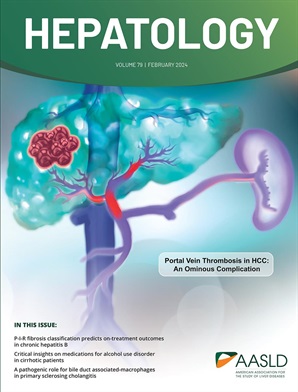AASLD Practice Statement on the evaluation and management of metabolic dysfunction-associated steatotic liver disease in children
IF 12.9
1区 医学
Q1 GASTROENTEROLOGY & HEPATOLOGY
引用次数: 0
Abstract
Given the high prevalence of metabolic dysfunction-associated steatotic liver disease (MASLD) in children and its distinct epidemiological, clinical, and histopathological differences from adult disease, the American Association for the Study of Liver Diseases (AASLD) commissioned this pediatric-focused evidence-based practice statement. A multidisciplinary writing group—encompassing expertise in pediatric hepatology, gastroenterology, endocrinology, and liver pathology—conducted a comprehensive PubMed literature search for studies published through March 6, 2024, involving pediatric participants (ages 0–18 y) with NAFLD or MASLD. The review addressed epidemiology, pathophysiology, natural history, screening, diagnosis, treatment, comorbidity management, outcome monitoring, and transition of care. Using the highest available level of evidence—randomized controlled trials, large observational cohort studies, systematic reviews, and meta-analyses—30 evidence-guided practice statements were developed. Where high-quality evidence was lacking, expert consensus was employed, and critical knowledge gaps were identified to inform future research priorities. This document highlights key concepts relevant to pediatric MASLD, especially regarding diagnostic criteria, noninvasive assessment tools, and therapeutic approaches. It also discusses the implications of the 2023 nomenclature revision, which emphasizes evaluating both hepatic steatosis and cardiometabolic risk factors. With increasing recognition of MASLD’s cardiometabolic burden and long-term health consequences, this practice statement provides a structured framework to advance clinical care and research in pediatric MASLD.AASLD关于儿童代谢功能障碍相关脂肪变性肝病评估和管理的实践声明
鉴于儿童代谢功能障碍相关脂肪变性肝病(MASLD)的高患病率及其与成人疾病在流行病学、临床和组织病理学上的独特差异,美国肝病研究协会(AASLD)委托撰写了这份以儿科为重点的循证实践声明。一个多学科写作小组,包括儿科肝病学、胃肠病学、内分泌学和肝脏病理学的专家,对截至2024年3月6日发表的研究进行了全面的PubMed文献检索,涉及患有NAFLD或MASLD的儿科参与者(0-18岁)。该综述涉及流行病学、病理生理学、自然史、筛查、诊断、治疗、合并症管理、结果监测和护理转移。利用最高水平的证据——随机对照试验、大型观察性队列研究、系统评价和荟萃分析——制定了30项循证指导的实践声明。在缺乏高质量证据的情况下,采用了专家共识,并确定了关键的知识差距,以便为未来的研究重点提供信息。本文件强调了与儿童MASLD相关的关键概念,特别是关于诊断标准、无创评估工具和治疗方法。它还讨论了2023年命名修订的影响,该修订强调评估肝脂肪变性和心脏代谢危险因素。随着越来越多的人认识到MASLD的心脏代谢负担和长期健康后果,本实践声明为推进儿科MASLD的临床护理和研究提供了一个结构化的框架。
本文章由计算机程序翻译,如有差异,请以英文原文为准。
求助全文
约1分钟内获得全文
求助全文
来源期刊

Hepatology
医学-胃肠肝病学
CiteScore
27.50
自引率
3.70%
发文量
609
审稿时长
1 months
期刊介绍:
HEPATOLOGY is recognized as the leading publication in the field of liver disease. It features original, peer-reviewed articles covering various aspects of liver structure, function, and disease. The journal's distinguished Editorial Board carefully selects the best articles each month, focusing on topics including immunology, chronic hepatitis, viral hepatitis, cirrhosis, genetic and metabolic liver diseases, liver cancer, and drug metabolism.
 求助内容:
求助内容: 应助结果提醒方式:
应助结果提醒方式:


